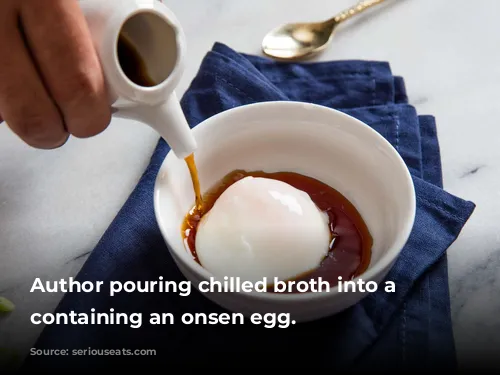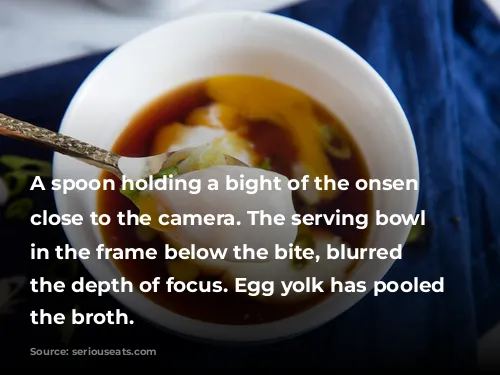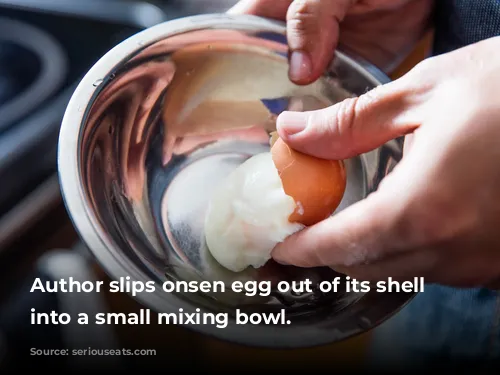Imagine a world before the fancy gadgets and techniques we use today. Back then, to get the perfect egg, people relied on the gentle warmth of nature itself. In Japan, they had onsen tamago, a dish born from the natural heat of geothermal springs, also known as onsen. These springs, famed for their therapeutic benefits, also provided the ideal temperature for cooking eggs.
Imagine dropping eggs into these springs, leaving them for a few hours, and returning to find the silkiest, most custardy eggs imaginable. The result? A culinary marvel, a testament to the simplicity and elegance of Japanese tradition.

From Onsen to Your Kitchen: The Perfect Onsen Tamago
Recently, I was fortunate enough to visit Dogo Onsen, a thousand-year-old hot spring in Matsuyama, Ehime. While staying at a nearby ryokan, I experienced the true meaning of onsen tamago. Served with a refreshing soy-dashi broth, the egg was simply exquisite.
But here’s the good news: You don’t need an onsen to create this delightful dish.

The Sous Vide Approach: Time and Precision
The immersion circulator, your kitchen’s new best friend, is a modern-day onsen. It allows you to precisely control the temperature, mimicking the natural warmth of the springs.
Just imagine: setting the circulator to 145°F and letting the egg cook for 45 minutes to one and a half hours. Over time, the whites will gently set, and the yolk will transform into a velvety custard. The result? A spectrum of textures and flavors, all under your control.

The Quick and Easy Method: The Perfect Balance
For those who don’t have the patience for the sous vide method, there’s a quicker alternative. This technique, championed by culinary experts Aki Kamozawa and Alex Talbot, involves cooking the egg at 167°F for a mere 13 minutes.
Imagine: the higher temperature creating a beautiful temperature gradient within the egg, resulting in slightly firmer whites transitioning to a luscious, runny yolk. It’s a symphony of textures and flavors, all achievable in a short amount of time.

Beyond the Gadget: The Art of Onsen Tamago
Don’t despair if you lack an immersion circulator. You can still achieve the perfect onsen tamago using a simple pot and a digital thermometer. The key? Maintaining a steady temperature of 167°F for 13 minutes.
Imagine: carefully adjusting the heat, ensuring the water stays within the ideal temperature range. The result? A perfectly cooked egg, a testament to your culinary skills.

From Kitchen to Table: Onsen Tamago’s Many Forms
Once your eggs are cooked, chill them and peel them. The whites may be slightly loose, a result of the gentle cooking process. Simply remove the excess with a paper towel or scoop the egg out.
Imagine: the possibilities! Onsen tamago can grace noodle soups, rice bowls, or even gyudon, but for me, the simplicity of the ryokan’s method reigns supreme.

The Art of the Broth: A Symphony of Flavors
The perfect onsen tamago broth is a blend of classic Japanese flavors: dashi, soy sauce, mirin, and a touch of sugar. But the perfect ratio remains a subject of debate.
Imagine: exploring different combinations, from a mild 8:1:1 ratio to a more assertive 4:1:1 mixture. Ultimately, I found my inspiration in Nancy Singleton Hachisu’s “Japanese Farm Food,” which incorporates a kaeshi mixture of soy sauce, mirin, and sugar. This method creates a broth with a complex depth of flavor.
The Legacy of Taste: A Culinary Journey
Imagine: learning from the experts. Hachisu’s kaeshi method was inspired by a renowned soba chef, Kanji Nakatani, who emphasizes that the ratios are simply guidelines, to be adjusted based on personal preferences and even the season.
Imagine: the freedom to customize the broth to your own taste, adding more dashi for a lighter touch or more kaeshi for a bolder, savory flavor.
A Culinary Symphony: Onsen Tamago’s Final Act
To serve, simply slide the eggs into small bowls and pour the chilled broth over them. Garnish with thinly sliced scallions for a touch of elegance.
Imagine: a taste of Japan, the perfect balance of flavors and textures, a culinary masterpiece born from simplicity and tradition. This is the essence of onsen tamago, a journey from the hot springs to your table, a testament to the artistry of Japanese cuisine.

